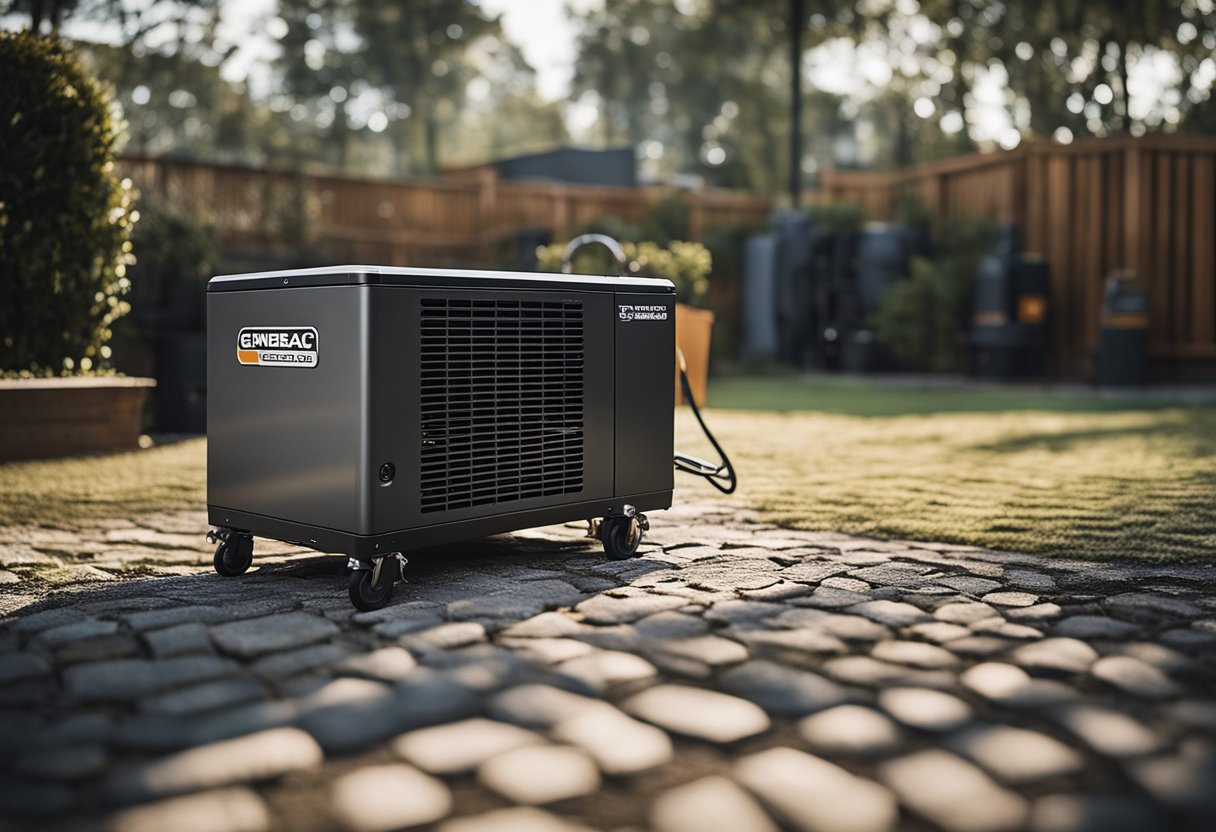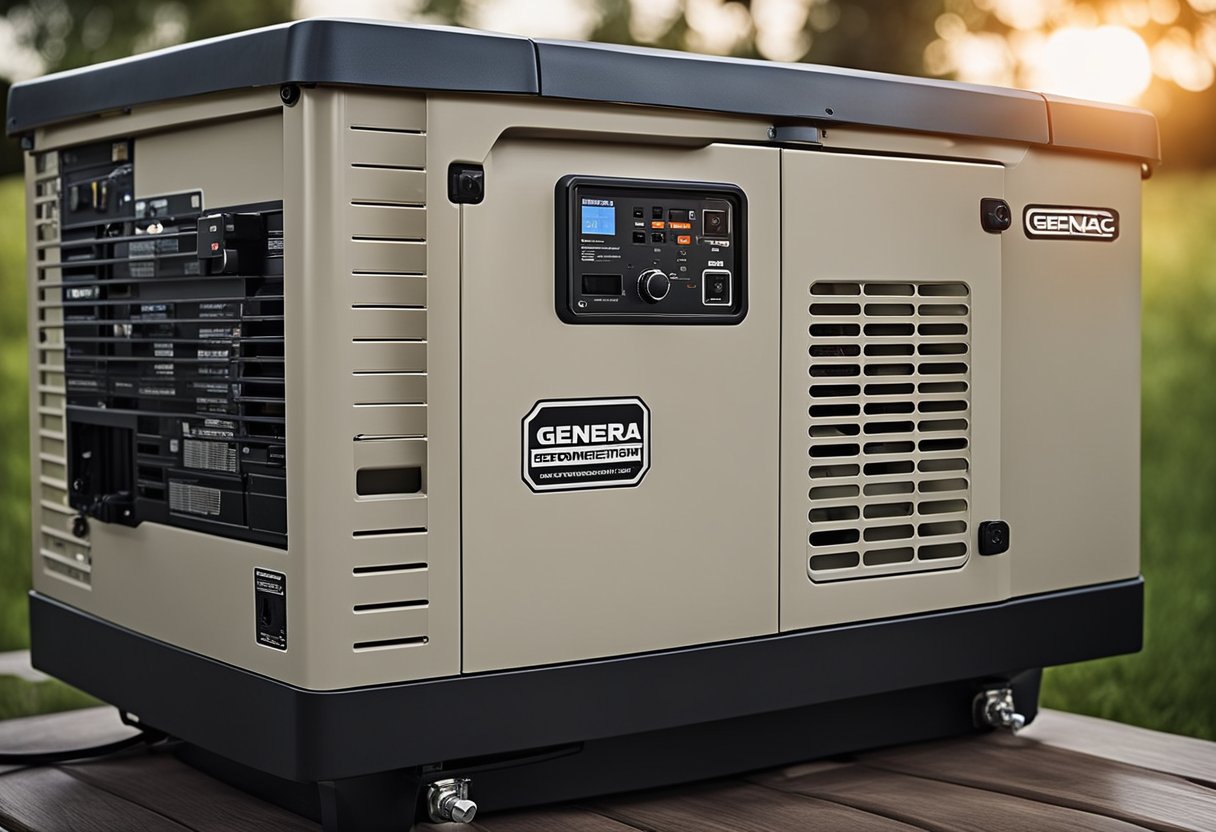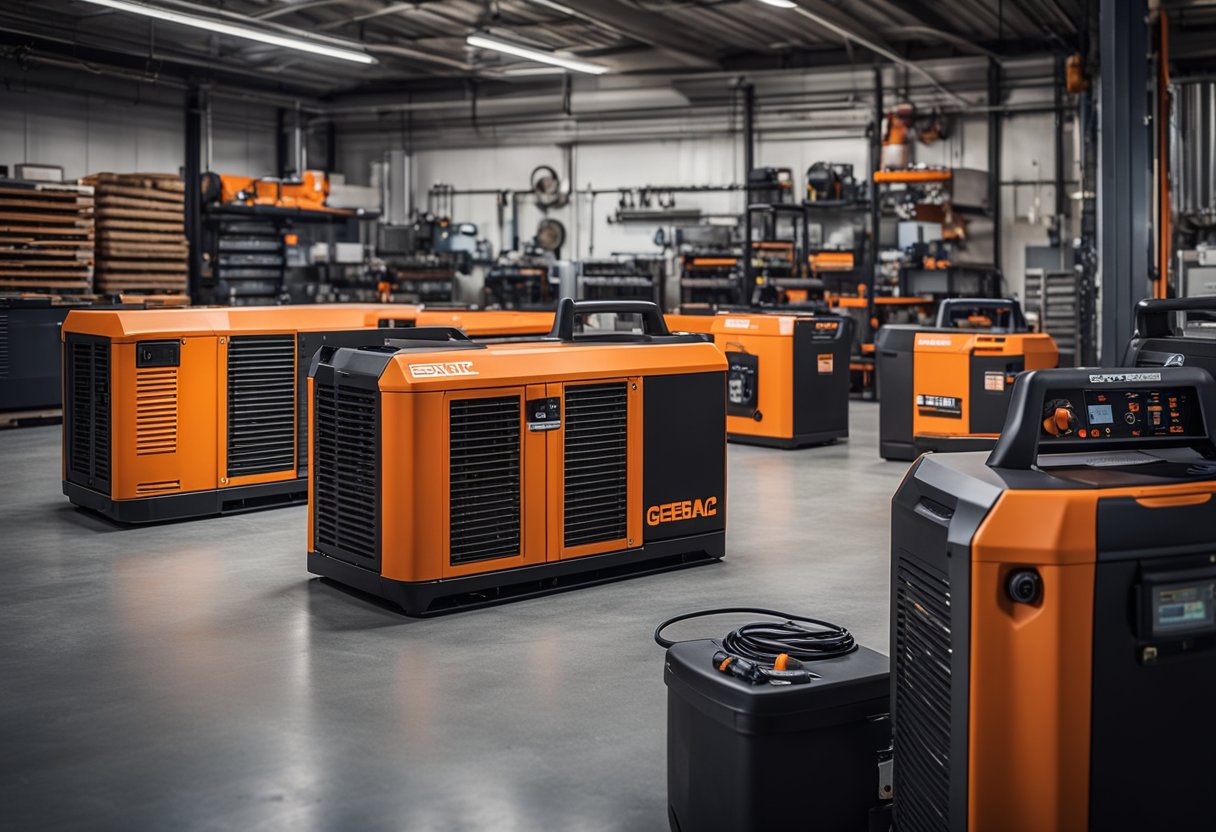Does a Generac Generator Charge Its Own Battery?
As a generator owner, you might be wondering if your Generac generator can charge its own battery. The answer is that it depends on the model and specifications of the generator. While some Generac generator models have a built-in charging system that can charge their own battery while running, others do not.
Understanding your generator and its battery essentials is crucial to ensure that it is always ready to power your home or appliances in case of a power outage. Generators work by converting mechanical energy into electrical energy, which is then stored in the battery. The charging mechanism of generators is designed to keep the battery charged and ready for use when needed.
Key Takeaways
- The ability of a Generac generator to charge its own battery depends on the model and specifications of the generator.
- Understanding the generator and its battery essentials is crucial to ensure that it is always ready to power your home or appliances in case of a power outage.
- Generators work by converting mechanical energy into electrical energy, which is then stored in the battery. The charging mechanism of generators is designed to keep the battery charged and ready for use when needed.
Understanding Generators
https://www.youtube.com/watch?v=yZZIE9p2HhQ&embed=true
Basics of Generators
Generators are devices that convert mechanical energy into electrical energy. They are commonly used to provide power during power outages or in areas where there is no access to electricity. Generators work by using an engine to turn a rotor that is surrounded by a magnetic field. As the rotor turns, it creates an electrical current that is collected and distributed through the generator’s outlets.
Generators come in different sizes and types. They can be portable or stationary, and they can run on different types of fuel, such as gasoline, diesel, or propane. Portable generators are great for outdoor activities, camping, and emergency situations. They are compact, easy to move around, and can provide power to small appliances and devices. Stationary generators, on the other hand, are designed to provide backup power to homes and businesses during power outages. They are usually powered by natural gas or propane and can provide power to the entire house or building.
Types of Generators
There are different types of generators available on the market, each with its own advantages and disadvantages. Some of the most popular generator brands include Generac, Honda EU2200i, Yamaha, DuroMax XP12000EH, and Westinghouse 12500 watts.
Generac generators are known for their reliability and durability. They are designed to provide backup power to homes and businesses during power outages. Generac GP8000E is a popular model that is capable of providing 8,000 watts of continuous power and 10,000 watts of surge power.
Honda EU2200i is a popular portable generator that is known for its quiet operation and fuel efficiency. It is capable of providing up to 2,200 watts of power and can run for up to 8.1 hours on a single tank of gas.
Yamaha generators are also known for their reliability and durability. They are designed to provide power to both residential and commercial applications. Yamaha EF2200iS is a popular model that is capable of providing up to 2,200 watts of power and can run for up to 10.5 hours on a single tank of gas.
DuroMax XP12000EH is a powerful generator that is capable of providing up to 12,000 watts of power. It is designed to run on both gasoline and propane, which makes it a versatile option for homeowners and contractors.
Westinghouse 12500 watts is a stationary generator that is designed to provide backup power to homes and businesses during power outages. It is capable of providing up to 12,500 watts of continuous power and 15,600 watts of surge power.
In conclusion, generators are vital devices that provide power in situations where there is no access to electricity. There are different types of generators available on the market, each with its own advantages and disadvantages. It is important to choose a generator that meets your specific needs and requirements.
Generator Battery Essentials
https://www.youtube.com/watch?v=bWISaPUMoNw&embed=true
As a generator owner, I know that the battery is an essential component of the generator system. Without a battery, the generator won’t start, and you won’t have any backup power during a power outage. Therefore, it is crucial to understand the basics of generator batteries, their types, and how to maintain them properly.
Battery Types
Generators usually have two types of batteries: sealed lead-acid batteries and flooded lead-acid batteries. Sealed lead-acid batteries are maintenance-free, while flooded lead-acid batteries require regular maintenance. Sealed lead-acid batteries are more expensive than flooded lead-acid batteries, but they are more reliable and have a longer lifespan.
Battery Life and Maintenance
The lifespan of a generator battery depends on several factors, such as the type of battery, usage, and maintenance. A well-maintained battery can last for up to five years, while a poorly maintained battery may only last for a year or two.
To extend the lifespan of your generator battery, you should perform regular maintenance. This includes checking the fluid levels regularly and topping up the battery with distilled water if necessary. You should also clean the battery terminals and cables regularly and inspect them for any signs of damage or corrosion. If you notice any damage or corrosion, you should replace the damaged parts immediately.
When storing your generator, you should remove the battery and store it in a cool, dry place. You should also charge the battery every three months to prevent it from discharging completely.
In summary, generator batteries are an essential component of the generator system, and it is crucial to understand their types and how to maintain them properly. By performing regular maintenance, you can extend the lifespan of your generator battery and ensure that your generator is ready to provide backup power during a power outage.
Charging Mechanism of Generators
https://www.youtube.com/watch?v=3larhkeqgh0&embed=true
As a generator owner, one of the questions you may have is whether your Generac generator can charge its own battery. In this section, I will explain how generators charge their own batteries and whether or not Generac generators can charge their own batteries.
How Generators Charge Their Own Batteries
Most generators require an external charger to charge their batteries. However, some generators, like the Generac GP models, have a built-in charging system that can charge the battery while the generator is running [1]. The charging mechanism of a generator is controlled by the generator’s control panel. The battery charger is powered from an external 120VAC load connection through a fuse located in the transfer switch [2].
When the generator is running, the alternator produces an electrical current that is used to power the generator and also to charge the battery. The charging voltage is typically between 13.5 and 14.5 volts [1].
External Chargers and Generators
If your generator does not have a built-in charging system, you will need to use an external charger to charge the battery. It is important to follow the manufacturer’s instructions and use the appropriate charger for optimal battery performance and longevity [3].
The time it takes to charge a generator battery depends on the battery’s capacity and the charger’s output. A typical 12-volt battery with a capacity of 100 amp-hours will take approximately 10 hours to charge with a 10-amp charger [2].
In conclusion, while some generators like the Generac GP models can charge their own batteries, most generators require an external charger to charge the battery. It is important to follow the manufacturer’s instructions and use the appropriate charger for optimal battery performance and longevity.
[1] Home Apricot. (n.d.). Does a Generator Charge Its Own Battery? (Explained). Retrieved November 24, 2023, from https://homeapricot.com/does-generator-charge-its-own-battery/
[2] Generac Power Systems. (2023, October 26). Home Standby Generator Battery Charging. Retrieved November 24, 2023, from https://support.generac.com/s/article/How-Is-My-Home-Standby-Generator-Battery-Charged
[3] GeneratorInspect. (n.d.). Does a Generator Charge Its Own Battery? Retrieved November 24, 2023, from https://generatorinspect.com/does-a-generator-charge-its-own-battery/
Understanding Generator Models and Specifications
Generac Generator Models
Generac is a well-known brand of generators that offers a range of models to meet different power needs. Generac generators come in various sizes, from portable generators to large standby generators. One of the popular models of Generac generators is the GP8000E. This generator is designed to provide reliable power during power outages and other emergencies. It has a powerful engine that can produce up to 8,000 watts of power, making it suitable for powering large appliances, tools, and other equipment.
Generator Specifications
When choosing a generator, it is essential to consider the generator’s specifications to ensure it meets your power needs. Generac generators come with various specifications, including the generator model, size, and power output. The generator model number is typically printed on the generator’s side and provides information about the generator’s specifications, such as its power output, engine size, and fuel capacity.
The Generac GP8000E generator has a running wattage of 8000 watts and a starting wattage of 10000 watts. It has a 420cc OHV engine and a 7.9-gallon fuel tank that can run for up to 11 hours at 50% load. It also has a built-in fuel gauge that allows you to monitor the fuel level easily. Additionally, it has an electric start feature that makes it easy to start the generator quickly.
In conclusion, understanding the specifications of a generator is essential when choosing the right generator for your needs. Generac generators are known for their reliability and durability and come in different models and sizes to meet various power needs. The GP8000E is a popular model that provides reliable power during power outages and other emergencies, making it an excellent choice for homeowners and businesses alike.
Electrical Energy and Generators
https://www.youtube.com/watch?v=efWuZBK73Pk&embed=true
As a generator technician, I am often asked whether a Generac generator can charge its own battery. Before answering this question, it’s important to understand how generators work and how they produce electrical energy.
Conversion of Energy in Generators
Generators convert mechanical energy into electrical energy. This conversion is achieved by an engine that burns fuel and converts the chemical energy in the fuel into mechanical energy. The mechanical energy is then converted into electrical energy by a generator.
The generator consists of a rotor and a stator. The rotor is a rotating part of the generator that is driven by the engine. The stator is a stationary part of the generator that contains the conductors that produce the electrical output.
When the rotor rotates, it creates a magnetic field that induces an electrical current in the conductors of the stator. This current is then collected by the output terminals of the generator and can be used to power electrical devices.
Electric Starters in Generators
Most modern generators come equipped with an electric starter. This starter is powered by a battery that is separate from the generator’s output. The battery is charged by the generator’s charging system, which is typically a built-in charging system that can charge the battery while the generator is running.
Generac generators are equipped with built-in automatic battery chargers, allowing them to charge their own batteries. However, not all Generac generators have this feature. Only the Generac 15000 & 17500 and the electric and XP series offer this option.
In conclusion, generators are an essential source of electrical energy. They convert mechanical energy into electrical energy, which can be used to power electrical devices. Generac generators can charge their own batteries, but this feature is not available on all models.
Usage of Generators
https://www.youtube.com/watch?v=2Ha1rgDmEKk&embed=true
As a generator owner, I have found that generators are extremely useful in times of power outages or when I need to power appliances and devices in remote locations. However, it is important to understand the proper usage of generators to ensure they function effectively and safely.
Running Appliances and Devices
Generators are designed to provide electricity to appliances and devices. To run appliances and devices, the generator must be connected to the appliance or device through a power cord. It is important to ensure that the generator is powerful enough to handle the electrical load of the appliances and devices being used. Overloading a generator can cause it to malfunction or even cause a fire.
Dealing with Dead Batteries
One question that often comes up is whether a generator can charge its own battery. According to my research, it depends on the model and make of the generator. For example, Generac Power Systems states that their Evolution control panel controls the battery charging, and the battery charger is powered from an external 120VAC load connection through the T1 fuse located in the transfer switch. The 120VAC source must be connected to the generator in order to operate the charger. Some Generac generator models, such as the GP 15000 and 17500, are capable of charging their own batteries. However, most generators require a separate external charger to charge their batteries.
In conclusion, generators are useful tools for powering appliances and devices in times of need. It is important to understand the proper usage of generators to ensure they function effectively and safely. When dealing with dead batteries, it is important to consult the manufacturer’s instructions and determine whether the generator is capable of charging its own battery or if an external charger is required.
Frequently Asked Questions
How does a Generac generator keep its battery charged?
Generac generators come with a battery charger that is powered from an external 120VAC load connection through the T1 fuse located in the transfer switch. The battery charging is controlled by the Evolution control panel. The control panel determines conditions that trigger the battery should charge, how long the battery should charge. [1]
What size battery is required for a Generac 22kW generator?
The recommended battery size for a Generac 22kW generator is Group 26R 12V 525 CCA. [2]
Does a Generac generator come with an alternator?
Yes, Generac generators come with an alternator. The alternator is responsible for producing the electrical power that the generator produces. [3]
Can a Generac generator charge its own battery?
Yes, a Generac generator can charge its own battery. The battery charger is powered from an external 120VAC load connection through the T1 fuse located in the transfer switch. Battery charging is controlled by the Evolution control panel. The control panel determines conditions that trigger the battery should charge, how long the battery should charge. [1]
How long does it take to charge a Generac generator battery?
The time it takes to charge a Generac generator battery depends on the battery size and the battery’s state of charge. A fully discharged battery can take up to 24 hours to charge. [1]
Is it possible to charge a Generac generator battery at home?
Yes, it is possible to charge a Generac generator battery at home. The battery charger is powered from an external 120VAC load connection through the T1 fuse located in the transfer switch. [1]

Hi, I’m Sal Muller of Tooltrip.com. My DIY experience led me to understand essential power tools for home projects. Tooltrip.com guides enthusiasts and professionals in choosing right tools for any job. I provide concise top tool reviews for easier, efficient DIY.




